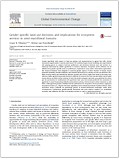| Journal Article |
 |
|
| Article Title | Gender specific land-use decisions and implications for ecosystem services in semi-matrilineal Sumatra | | Author | Grace B.Villamor and Meine van Noordwijk | | Year | 2016 | | Journal Title | Global Environmental Change | | Institution | Elsevier Ltd | | Volume | 39 | | Pages | 69-80 | | Call Number | JA0653-16 | | Keywords | Agent-based model, Ecosystem service tradeoffs, Bounded rationality, Bounded willpower, Bounded self-interest, Jambi |
|
| Abstract: |
| Gender specificity with respect to land-use options and responsiveness to agents that offer related
investment opportunities is poorly understood. We combined agent-based modeling and experimental
role playing games to compare land-use preferences and decisions between men and women in a
landscape dominated by rubber agroforests in Sumatra, Indonesia. Ecosystem service delivery can be
influenced by gender specific land-use preferences, especially in areas under conservation agreements.
The research methods were designed to examine gender aspects of three ‘bounds’ of human nature (bounded rationality, bounded willpower and bounded self-interests) in relation to land-use decisions. Rice
fields (mostly owned and inherited by females) provide part of local staple food needs in the study area,
whereas rubber agroforests provide income in addition to resources for local use and rubber and oil palm
monocultures are fully market oriented. In both the model and game exercises, men preferred the status
quo rice production in combination with agroforest land uses, but women preferred the conversion of
agroforest to more
financially profitable monoculture systems, with increased carbon emissions as side
effect. Although both genders exhibited similar preferences for ecosystem service provision, regulatory
ecosystem services (i.e., climate and water regulation) were reduced by women’s landuse choices. Thus,
ecosystem service tradeoffs are potentially greater in women-dominated landscapes under these
circumstances. Furthermore, gender-specific limitations and socio-cultural contexts (i.e., matrilineal
societies) may influence the
flow of ecosystem services as well as landscape patterns. |
|